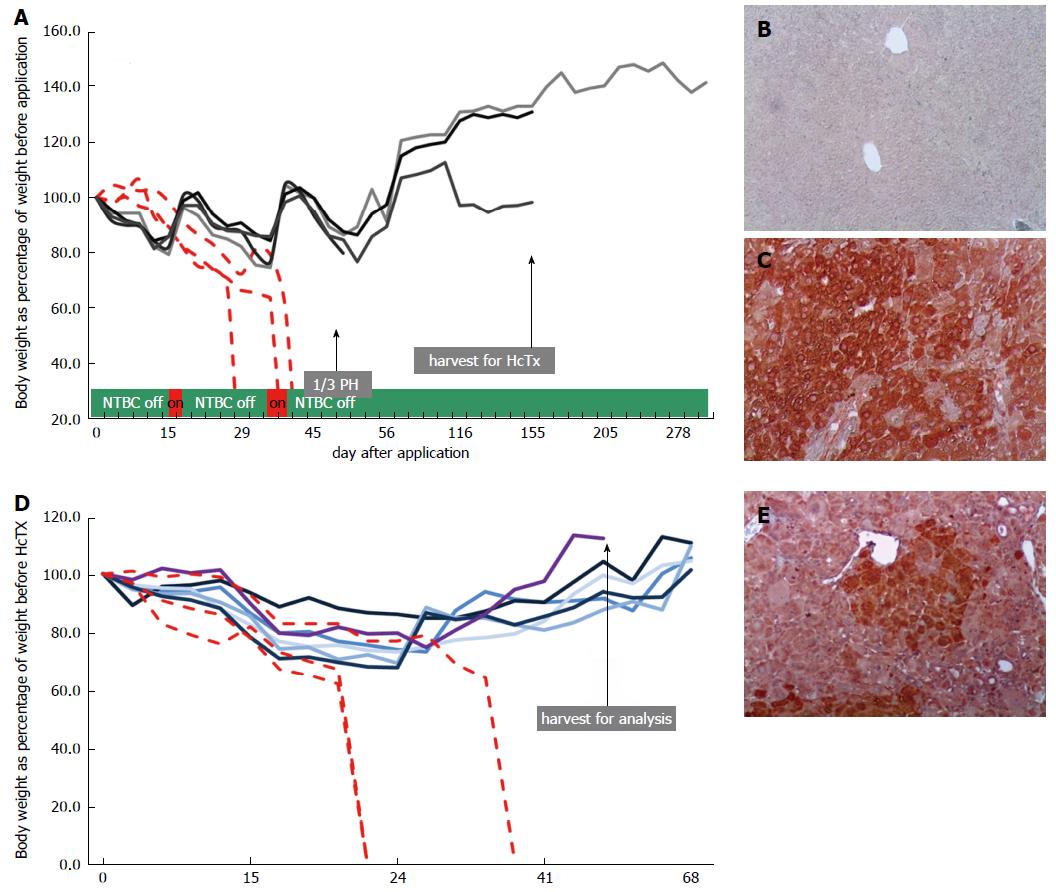Copyright
©The Author(s) 2018.
World J Hepatol. Feb 27, 2018; 10(2): 277-286
Published online Feb 27, 2018. doi: 10.4254/wjh.v10.i2.277
Published online Feb 27, 2018. doi: 10.4254/wjh.v10.i2.277
Figure 2 Mice treated with rAAV8-ROSA26.
HAL-TTR.Fah-ROSA26HAR. A: Weight graph and survival for first-generation mice (n = 4) injected with rAAV8-ROSA26.HAL-TTR.Fah-ROSA26HAR and 3 untreated controls (injected with sodium chloride). Continuous line = rAAV8-ROSA26.HAL-TTR.Fah-ROSA26HAR mice, broken line = controls (same control mice as displayed at Figure 3A). Body weight is displayed as percentage of body weight at the time of virus injection or sodium chloride injection (controls). The timeline (x-axis) is displayed in days beginning with the day of virus/sodium chloride injection as day zero; B: FAH staining of liver tissue from controls (mice with sodium chloride injection) after death (100 × magnification); C: FAH staining of liver tissue from partial hepatectomy in mouse injected with rAAV8-ROSA26.HAL-TTR.Fah-ROSA26HAR (100 × magnification); D: Weight graph and survival for second-generation mice (continuous line), which were transplanted with one million hepatocytes from mice primarily injected with rAAV8-ROSA26.HAL-TTR.Fah-ROSA26HAR and controls (same control mice as displayed at Figure 3D) without hepatocyte transplantation (broken line). Body weight is displayed as percentage of body weight at time of hepatocyte transplantation. The timeline (x-axis) is displayed in days, beginning with the day of hepatocyte transplantation as day zero; E: FAH staining of liver tissue from a partial hepatectomy from a second-generation mouse, which received one million hepatocytes from mice primarily injected with rAAV8-ROSA26.HAL-TTR.Fah-ROSA26HAR (100 × magnification). 1/3PH: One third partial hepatectomy; HcTx: Hepatocyte transplantation.
- Citation: Junge N, Yuan Q, Vu TH, Krooss S, Bednarski C, Balakrishnan A, Cathomen T, Manns MP, Baumann U, Sharma AD, Ott M. Homologous recombination mediates stable Fah gene integration and phenotypic correction in tyrosinaemia mouse-model. World J Hepatol 2018; 10(2): 277-286
- URL: https://www.wjgnet.com/1948-5182/full/v10/i2/277.htm
- DOI: https://dx.doi.org/10.4254/wjh.v10.i2.277









